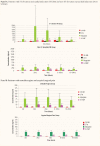Heart-Type Fatty Acid-Binding Protein in the Early Diagnosis of Acute Myocardial Infarction: The potential for influencing patient management
- PMID: 21509080
- PMCID: PMC3074640
Heart-Type Fatty Acid-Binding Protein in the Early Diagnosis of Acute Myocardial Infarction: The potential for influencing patient management
Abstract
Objectives: The objective of this study was to evaluate the diagnostic value of heart-type fatty acid-binding protein (H-FABP) in patients with acute chest pain and compare it with standard cardiac markers.
Methods: We undertook a prospective evaluation of 100 consecutive patients admitted with acute chest pain suggestive of acute coronary syndromes (ACS). Serum cardiac troponin I (cTnI), cardiac troponin T (cTnT), creatine kinase-MB (CK-MB) mass, myoglobin, and H-FABP were determined at presentation and 2, 4, 8-10, and 16-24 hours after presentation. The main outcome measure was the best sensitivity value within 6 hours after symptom onset.
Results: H-FABP peak concentration occurred at 8 hours after symptoms onset and was the most sensitive early marker with 79.9% and 98% of patients with AMI identified at presentation and 2 hours after presentation respectively. The sensitivity of all other cardiac markers (CK-MB mass, cTnI, cTnT, and myoglobin) at presentation was < 62%. The negative predictive value of H-FABP (94%) was also superior to other markers within the first 2 hours of presentation. Myoglobin was the second most sensitive early marker at presentation. Peak sensitivity of cTnI, CK-MB mass, and cTnT were present at 4, 8-10, and 8-10 hours respectively after presentation.
Conclusion: Combined measurement of H-FABP and cTnI on two occasions during the first 8 hours after symptom onset was sufficiently sensitive and specific for the early diagnosis of most patients with acute MI and may provide advantages over other cardiac marker combinations.
Keywords: Acute coronary syndromes; Acute myocardial infarction; Cardiac markers; Heart-type fatty acid-binding protein.
Figures



Similar articles
-
Human heart-type cytoplasmic fatty acid-binding protein (H-FABP) for the diagnosis of acute myocardial infarction. Clinical evaluation of H-FABP in comparison with myoglobin and creatine kinase isoenzyme MB.Clin Chem Lab Med. 2000 Mar;38(3):231-8. doi: 10.1515/CCLM.2000.034. Clin Chem Lab Med. 2000. PMID: 10905760
-
Heart-type fatty acid binding protein--a reliable marker of myocardial necrosis in a heterogeneous group of patients with acute coronary syndrome without persistent ST elevation.Kardiol Pol. 2008 Mar;66(3):253-9, discussion 260-1. Kardiol Pol. 2008. PMID: 18393112
-
Serum markers in the emergency department diagnosis of acute myocardial infarction.Emerg Med Clin North Am. 2001 May;19(2):321-37. doi: 10.1016/s0733-8627(05)70186-3. Emerg Med Clin North Am. 2001. PMID: 11373981 Review.
-
The use of human heart-type fatty acid-binding protein as an early diagnostic biochemical marker of myocardial necrosis in patients with acute coronary syndrome, and its comparison with troponin-T and creatine kinase-myocardial band.Heart Vessels. 2006 Sep;21(5):309-14. doi: 10.1007/s00380-006-0908-2. Epub 2006 Sep 29. Heart Vessels. 2006. PMID: 17151819
-
Laboratory diagnosis of patients with acute chest pain.Clin Chem Lab Med. 2000 Mar;38(3):187-97. doi: 10.1515/CCLM.2000.027. Clin Chem Lab Med. 2000. PMID: 10905753 Review.
Cited by
-
Increase in cardiac myosin binding protein-C plasma levels is a sensitive and cardiac-specific biomarker of myocardial infarction.Am J Cardiovasc Dis. 2013 Jun 10;3(2):60-70. Print 2013. Am J Cardiovasc Dis. 2013. PMID: 23785583 Free PMC article.
-
Serum level of heart-type Fatty Acid-binding protein in patients with chronic renal failure.Sultan Qaboos Univ Med J. 2009 Dec;9(3):311-4. Epub 2009 Dec 19. Sultan Qaboos Univ Med J. 2009. PMID: 21509315 Free PMC article.
-
Heart-type fatty acid-binding protein (H-FABP) as an early diagnostic biomarker in patients with acute chest pain.Indian Heart J. 2015 Nov-Dec;67(6):538-42. doi: 10.1016/j.ihj.2015.06.035. Epub 2015 Oct 26. Indian Heart J. 2015. PMID: 26702681 Free PMC article.
-
Heart-Type Fatty Acid-Binding Protein, in Early Detection of Acute Myocardial Infarction: Comparison with CK-MB, Troponin I and Myoglobin.Indian J Clin Biochem. 2016 Oct;31(4):439-45. doi: 10.1007/s12291-015-0544-7. Epub 2016 Jan 13. Indian J Clin Biochem. 2016. PMID: 27605741 Free PMC article.
-
Diagnostic Value of Echocardiography Combined with Serum h-FABP and cTnI in Myocardial Infarction and Its Evaluation Value in Left Ventricular Function.Evid Based Complement Alternat Med. 2022 May 24;2022:8809708. doi: 10.1155/2022/8809708. eCollection 2022. Evid Based Complement Alternat Med. 2022. Retraction in: Evid Based Complement Alternat Med. 2023 Jun 21;2023:9850326. doi: 10.1155/2023/9850326. PMID: 35656464 Free PMC article. Retracted.
References
-
- British Heart Foundation Statistics Database 1999. Coronary Heart Disease Statistics. London: British Heart Foundation; 2002. 2002.
-
- Puleo PR, Meyer D, Wathen C, Tawa CW, Wheeler S, Humburg RJ, et al. Use of a rapid assay of subforms of creatine kinase-MB to diagnose or rule out acute myocardial infarction. N Engl J Med. 1994;331:561–6. - PubMed
-
- Woo J, Lacbawan FL, Sunheimer R, McCabe JB. Is myoglobin useful in the diagnosis of acute myocardial infarction in the emergency department setting? Am J Clin Pathol. 1995;103:725–9. - PubMed
-
- Glatz JF, van Bilsen M, Paulussen RJ, Veerkamp JH, Van der Vusse GJ, Reneman RS. Release of fatty acid-binding proteins from isolated rat heart subjected to ischemia and reperfusion or to the calcium paradox. Biochem Biophys Acta. 1988;961:148–52. - PubMed
-
- Glatz JF, van der Vusse GJ, Simoons ML, Kragten JA, Van Dieijen-Visser MP, Hermens WT. Fatty acid-binding protein and the early detection of acute myocardial infarction. Clin Chim Acta. 1998;272:87–92. - PubMed
LinkOut - more resources
Full Text Sources
Research Materials
Miscellaneous
